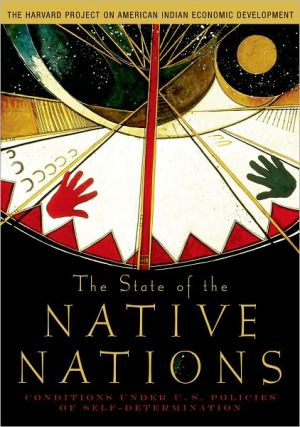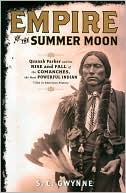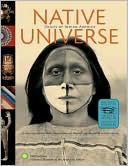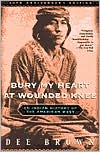The State of the Native Nations
Media filters and personal preconceptions can make it hard to get a clear view of present-day Indian America. The reality is that the 500+ Native nations in the United States confront many of the same day-to-day challenges that are faced by other nations and communities--raising children with strong identities, practicing religion, providing economic sustenance, strengthening culture, managing business and governmental affairs, and protecting public health and safety--but they are doing so...
Search in google:
Media filters and personal preconceptions can make it hard to get a clear view of present-day Indian America. The reality is that the 500+ Native nations in the United States confront many of the same day-to-day challenges that are faced by other nations and communities—raising children with strong identities, practicing religion, providing economic sustenance, strengthening culture, managing business and governmental affairs, and protecting public health and safety—but they are doing so from foundations built on their distinct histories, cultures, and circumstances. The State of the Native Nations: Conditions under U.S. Policies of Self-Determination chronicles the efforts, obstacles, and accomplishments that are shaping Indian Country under contemporary federal policies and responsive tribal strategies of self-determination. In The State of the Native Nations, the Harvard Project on American Indian Economic Development brings together scholars and Native leaders to produce the most comprehensive, cohesive interdisciplinary study available on current conditions and trends in Indian Country. Broad in scope and thematically organized, the volume features twenty-three chapters covering issues ranging from tribal governance, land and natural resources, and economic and social development, to arts and culture, the large off-reservation Native population, and federal Indian policy. Fourteen accompanying essays bring to life the personal perspectives of noted national leaders in Native affairs. The result is invaluable insight into the universal challenges of creating resilient, sustained, and self-determined communities.FEATURES:* Balances first-person accounts and field findings with extensive and up-to-date data and facts* Emphasizes the critical issues of Native self-determination and nation-building* Puts contemporary issues in their historical and policy contexts* Integrates case studies that highlight successful examples of the practice of Native nation self-determination
The Harvard Project on American Indian Economic DevelopmentContributorsThe Sounding BoardPreface and AcknowledgmentsA Note on Methodology and TerminologyIntroduction The Long Road to Self-Determination Contemporary RealitiesPART ONE: TRIBES AS NATIONS 1. Tribal Government The Evolution of Governmental Forms Federal Policy and Self-Governance The Importance of Capable Institutions of GovernanceElders Cultural Advisory Council, San Carlos Apache Tribal Governments and Nation Building Civil Society and Community Organizations Tribe-to-Tribe RelationsWe Are a Sovereign Government, Hon. W. Ron Allen2. Tribal Jurisdiction Underlying Principles of Tribal Jurisdiction Adjudicatory Authority Regulatory AuthorityChoctaw Tribal Court System, Mississippi Band of Choctaw Indians Challenges to Tribal Jurisdiction Taxing Authority Nation Building and Tribal CourtsThe Life Way and the Law Way, Hon. Robert Yazzie3. Tribal-Federal Relations The Federal Government's Trust Responsibility Federal Paternalism The Evolution of Federal-Tribal RelationsZuni Eagle Sanctuary, Zuni Fish and Wildlife Department, Pueblo of Zuni Underfunding by Federal Agencies Federal Recognition Tribes and Federal Politics The Future of Federal-Tribal RelationsPromoting Self-Determination, Benjamin Nuvamsa4. Tribal-State Relations Tribal versus State Authority Increased Interaction between States and Tribes New Models of Cooperation The Benefits of CooperationHonoring Our Ancestors: The Chippewa Flowage Joint Agency Management Plan, Lac Courte Oreilles Band of Lake Superior Chippewa Indians Educate. Educate. Educate. Hon. Marge Anderson5. International Relations Historical International Relations The United Nations and Indigenous Peoples Other International Institutions The Road AheadIroquois Nationals Lacrosse PART TWO: ASSETS AND ECONOMY 6. Native Lands A History of Dispossession Indian Lands Today Land Challenges Reacquiring and Reinstating Indian Lands Land Use PlanningSwinomish Cooperative Land Use Program The Future of Indian Lands7. Economic Development Past Efforts and Policies A Tribal Economic Development Snapshot The Underpinnings of Contemporary Tribal Economic DevelopmentHo-Chunk, Inc., Winnebego Tribe of Nebraska Strategies for Economic Development Ongoing Challenges in Economic Development Land and Jurisdiction The Future of Economic Development in Native AmericaSovereignty Is an Asset,, Sherry Salway Black8. Gaming The Development of Contemporary Indian GamingA Policy Primer on American Indian Gaming The Growth of Indian Gaming Socioeconomic Investment and ChangeQuil Ceda Village, The Tulalip Tribes Gaming Controversies The Future of Indian Gaming9. Natural Resources Historical Context Natural Resources in Indian Country Tribal Management of Natural Resources Energy Forestry AgricultureOneida Nation Farms and Agriculture Center, Oneida Nation of Wisconsin Water The Outlook for Natural Resources on Indian LandsMeeting the Natural Resource Challenges in Indian Country, Arthur "Butch" Blazer10. Environment Historical Context The Environmental State of Indian Country Challenges of Tribal Environmental Protection Tribal-Federal Cooperation in Addressing Current ProblemsWater Quality Standards, Environmental Department, Pueblo of Sandia Tribal Environmental Capacity The Future of Tribal Environmental ManagementPreservation of Life: Guiding Principles of Indian Tribal Governments, Susan M. Williams and Sarah WorksPART THREE: SOCIAL DEVELOPMENT 11. Education From Degradation to Empowerment The State of Educational Attainment Primary and Secondary Education Tribally Operated Schools No Child Left Behind Post-Secondary EducationThe Two-Plus-Two-Plus-Two Program, Hopi Junior/Senior High School, Hopi Nation The Tribal Colleges and Universities The Future of Indian EducationEducating a Closed Population Pool, James Shanley12. Health History Health Status Critical Underfunding of the Indian Health-Care System Self-Determination and Health Care Toward Progress in Indian HealthWhirling Thunder Wellness Program, Winnebago Tribal Health Department, Winnebago Tribe of Nebraska Health Care: A Trust Responsibility, A Sovereign Right, Yvette Roubideaux13. Family Support History of the Destruction of Native Families The Growth of Modern Welfare Programs Family Poverty in Indian Country Today Impact of Federal Welfare Reform Implementing TANF in Indian Country At-Risk Children Building a Future for FamiliesFond du Lac Foster Care Licensing and Placement Agency, Fond du Lac Lake Superior Band of Chippewa 14. Housing Early Indian Housing Policy The State of Indian Housing Challenges in Federal Indian Housing Policy Self-Determination in Housing Challenges AheadChuka Chukmasi Home Loan Program, Division of Housing, Chickasaw Nation 15. Public Safety History Status Public Safety Issues in Indian Country Policy Responses Toward Improved Public Safety in Indian CountryKake Circle Peacemaking, Organized Village of KakePART FOUR: CULTURE, ARTS, AND MEDIA 16. Culture Diverse American Indian Cultures Policies and Processes of Cultural Suppression The Status of Indian Languages Native Cosmologies and ReligionsOjibwe Language Program, Department of Education, Mille Lacs Band of Ojibwe Cultural Artifacts, Repatriation, and Museums Indigenous Knowledge Culture's Role in Shaping the Future of Native AmericaA Valued Past and a Vibrant Present, Hartman Lomawaima17. Arts The Arts in Native AmericaCherokee National Youth Choir, Cherokee Nation The Marketing of Indian Arts and Crafts Defining and Redefining Contemporary Indian ArtsAmerican Indian Art: A Way of Life, Kevin Red Star18. Media The Development of Media Perspectives Media in Native America The Question of the Ownership of Indian Media New Approaches to Media Issues The Growing Role of the Internet Looking to the FuturePART FIVE: ALASKA NATIVES, NATIVE HAWAIIANS, AND URBAN INDIANS 19. Alaska Natives History Alaska Natives and the Settlement of Land Claims Alaska Native Socioeconomic Status Challenges for Alaska NativesYukaana Development Corporation, Louden Tribal Council Prospects for the FutureSovereignty in Alaska, Willie Kasayulie20. Native Hawaiians Historical Context Who Are Native Hawaiians?Current Conditions Native Hawaiian Policy and Governance21. Urban Indians History The Socioeconomic Status of Urban Native Americans Policy Considerations Urban Indian Community Centers Self-Determination for Urban Indians Future ProspectsMenominee Community Center of Chicago, Menominee Indian Tribe of Wisconsin A Different Kind of Immigrant, Sydney BeaneConclusion Defending Tribal Sovereignty, Jacqueline JohnsonIndex
\ From the Publisher"This uniquely collaborative book comprehensively tells the compelling story of indigenous nations in a way unlike any other. Bursting with empirical data not readily available, and brimming with practical and scholarly insights, it is a must-read for anyone interested in the current situation of America's senior nations-its First Nations."--David Wilkins, University of Minnesota\ "The State of the Native Nations fills a void that currently exists for easily accessible, self-contained reflective research related to building Native nations. It will certainly be a sought after course reader within Native programs throughout the US and Canada."--Gregory Cajete, University of New Mexico\ \ \








